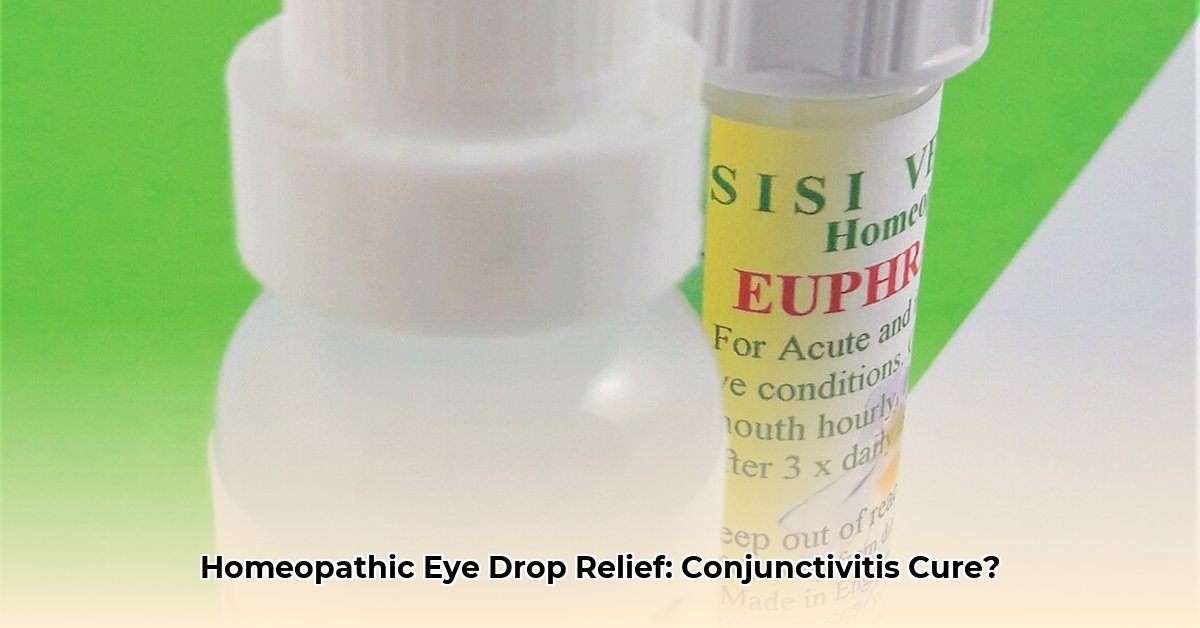Dealing with pink eye (conjunctivitis)? It’s incredibly uncomfortable, and you might be exploring all your options for relief. Remember to properly dispose of old eye drops; learn more about expired eye drops. This article takes a look at homeopathic eye drops as a possible approach. We’ll explore what homeopathy is, examine the evidence (or lack thereof) for its effectiveness against conjunctivitis, and offer practical advice if you’re considering this route. We’ll be upfront about what science says and what it doesn’t say, and we’ll stress the importance of seeing a doctor if your pink eye doesn’t improve or gets worse. Think of it as a balanced look at homeopathy for pink eye, helping you make informed decisions about your care.
Eye Drops Homeopathy: A Natural Approach to Pink Eye Relief
Pink eye, or conjunctivitis, is a real pain. That itchy, burning, watery feeling can really disrupt your day. Most people reach for standard eye drops from the drugstore. But what if you’re looking for something a bit more natural? Let’s explore the world of homeopathic eye drops for conjunctivitis relief and discover alternate healing modalities.
Understanding Homeopathy for Eye Issues
Homeopathy is a distinct approach to healthcare. Instead of directly combating symptoms with conventional medicine, it aims to stimulate your body’s self-healing capabilities. It’s like giving your body a gentle boost in the right direction. How does it accomplish this? It employs highly diluted substances, meticulously selected to correspond with your specific symptoms, a core concept known as the “law of similars”. This embodies a truly personalized approach to wellness and alternative medicine practices.
Several homeopathic remedies are frequently discussed in relation to pink eye:
- Euphrasia (Eyebright): Often the primary choice for excessively watery eyes, providing relief from the constant overflow associated with conjunctivitis.
- Belladonna (Deadly Nightshade): Suited for sudden-onset pink eye characterized by bright red, swollen eyes, addressing acute inflammation effectively.
- Pulsatilla (Windflower): Recommended for thicker, yellowish-green discharge, indicative of a potentially more serious infection, and supporting natural eye health.
- Cineraria maritima (Dusty Miller): A frequently mentioned ingredient in homeopathic eye drop products, addressing various eye problems beyond just conjunctivitis.
- Argentum Nitricum (Silver Nitrate): Considered when copious mucopurulent eye discharges are present with sticky eyelids. The conjunctiva is markedly red and swollen.
- Apis Mellifica (Honey Bee): Useful for swelling, pain, allergy eyes, heat and pressure sensation.
The Science (or Lack Thereof) Behind Homeopathic Eye Treatments
While numerous individuals advocate for homeopathic treatments, reporting positive experiences, it’s crucial to acknowledge the scarcity of definitive scientific studies validating their efficacy for pink eye. Many homeopathic remedies undergo such extreme dilution that doubts arise regarding the presence of any original substance. This constitutes a fundamental point of contention between homeopathy and conventional medicine. Further research is imperative to substantiate these claims.
Using Homeopathic Eye Drops: A Simple Guide
Even with natural remedies, careful planning is essential. Here’s a guide on using homeopathic eye drops for pink eye responsibly:
- Consult a Homeopath: Seeking guidance from a qualified homeopathic practitioner is the optimal method for determining the appropriate remedy. They can assess your specific symptoms and overall health to identify the most suitable remedy. This ensures a personalized treatment plan.
- Adhere to Instructions Diligently: Once you obtain your remedy, meticulously follow your practitioner’s instructions regarding dosage and frequency.
- Monitor Progress Closely: Vigilantly observe any changes in your symptoms. Document whether you experience improvement or if your eye remains red and inflamed. Consistent tracking of conjunctivitis symptoms is crucial.
- Seek Timely Medical Attention: If your condition fails to improve within a reasonable timeframe or exhibits deterioration, promptly consult a doctor. Seeking professional evaluation is preferable to allowing the condition to escalate, thereby prioritizing eye care.
- Maintain Hygiene: Diligently practice good hygiene, including frequent hand washing, to prevent the spread of infection. Refrain from touching your eyes to minimize further irritation or contamination.
Homeopathic Eye Drops vs. Traditional Treatments: A Side-by-Side Look
Let’s compare homeopathic eye drops to the traditional eye drops you might find at your local pharmacy, for a balanced perspective on eye health and treatment options:
| Feature | Homeopathic Eye Drops | Conventional Eye Drops |
|---|---|---|
| Approach | Stimulates the body’s natural healing process | Directly targets the infection or allergy |
| Scientific Evidence | Limited; mostly based on individual experiences | Extensive research and clinical trials support effectiveness |
| Possible Side Effects | Generally mild, but individual reactions can vary | Can cause burning, stinging, or allergic reactions; some may have preservatives |
| Personalization | Customized treatment based on your unique situation | Often a one-size-fits-all approach |
| Availability | Typically requires consultation with a homeopath | Readily available over-the-counter or by prescription |
| Cost | Varies; can be comparable to or more expensive than OTC drops | Generally affordable, especially OTC options |
Considering Homeopathy for Pink Eye: Making an Informed Decision
Homeopathy presents a potential alternative for individuals seeking a gentler approach to pink eye treatment, avoiding harsh chemicals. However, given the limited scientific evidence supporting its efficacy, a balanced perspective is essential. Weigh the potential benefits of this gentler approach against the proven effectiveness and extensive research associated with conventional treatments.
Ultimately, your health remains paramount. Consult your doctor or a qualified homeopathic practitioner before initiating any treatment decisions that may impact your ocular health. They can assist you in evaluating the advantages and disadvantages, formulating a plan that aligns with your specific needs. Remember, healthcare decisions are highly individualized. What yields positive results for one person may not necessarily yield the same outcomes for another.
How to choose the best homeopathic remedy for conjunctivitis based on symptoms
Key Takeaways:
- Several homeopathic remedies are frequently suggested for conjunctivitis, but choosing the right one depends entirely on your specific symptoms.
- The most commonly mentioned remedies are Euphrasia, Pulsatilla, and Belladonna, each linked to different symptom patterns, serving as alternative medicine options.
- Scientific evidence supporting homeopathy’s effectiveness for conjunctivitis is limited. More research is needed in alternative therapies.
- Always consult a qualified homeopath for personalized advice. Conventional medical care is crucial if symptoms worsen or persist, ensuring comprehensive eye care.
- Proper hygiene practices, such as frequent hand washing, are crucial in preventing the spread of conjunctivitis, regardless of the treatment approach.
Understanding Homeopathic Principles for Conjunctivitis
Homeopathy operates on the “law of similars.” This principle suggests that a substance capable of inducing symptoms in a healthy individual possesses the potential to alleviate analogous symptoms in a sick individual, particularly when administered in highly diluted formulations. This approach contrasts with conventional medicine, which typically targets specific pathogens directly. In the context of conjunctivitis, this entails prioritizing the individual’s unique symptom presentation rather than solely addressing “pink eye” as a uniform condition. It’s akin to a tailor-made solution, rather than a generic approach, offering customized symptom relief.
Common Homeopathic Remedies and Their Symptom Profiles
Numerous remedies frequently arise in discussions pertaining to homeopathic treatment for conjunctivitis. Let’s explore the most prevalent ones, recognizing the significance of evidence-based remedies:
| Remedy | Characteristic Symptoms | Discharge Type | Other Notable Symptoms |
|---|---|---|---|
| Euphrasia (Eyebright) | Burning, stinging, watery discharge, often improved in open air | Watery, acrid | Often feels better outdoors; may have a bland nasal discharge |
| Pulsatilla (Windflower) | Mild conjunctivitis, thick yellow/green discharge, sensitive to warmth | Thick, yellowish-green, mucopurulent | Often emotionally sensitive; desires open air; may have sticky eyelids in the morning |
| Belladonna (Deadly Nightshade) | Intense redness, swelling, dry eyes, burning | Minimal or absent | Severe pain, acute onset; sensitivity to light (photophobia); pupils may be dilated |
| Argentum Nitricum (Silver Nitrate) | Copious mucopurulent discharge, sticky eyelids, red and swollen conjunctiva | Copious, mucopurulent | Agglutinated eyelids, especially in the morning; fear of crowds |
| Aconite (Monkshood) | Sudden onset, redness, heat, and a gritty sensation in the eyes. | Thin and watery | Symptoms are often accompanied by anxiety and restlessness. |
Remember, these are general guidelines. Your symptoms might not perfectly align with a single category. A homeopath can assist you in identifying the most appropriate match for your specific condition and ensure proper conjunctivitis management and overall wellness.
How to Choose the Right Remedy: A Step-by-Step Guide
How to choose the best homeopathic remedy for conjunctivitis based on symptoms involves careful observation and description, a critical aspect of holistic health. Here’s a structured process:
- Detailed Symptom Assessment: Meticulously note the color, consistency,
- The Best Bento Box Price For Your Perfect Packed Lunch - December 15, 2025
- Bento Box Shopping Tips for Smart and Stylish Lunch Prep - December 14, 2025
- Bento Box Trays Streamline Restaurant Meal Presentation and Transport - December 13, 2025










